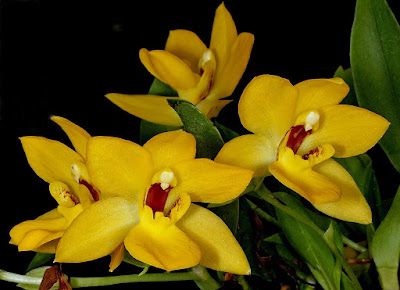Promenaea xanthina is native to Brazil. This orchid grows at an altitude of about 1700 m in the cool mountains near the south-east coast in the states of Espirito Santo, Rio de Janeiro, Sao Paulo, Parana and Minas Gerais. These plants usually grow on trees, but sometimes they grow on rocks...
Promenaea xanthina also called as The Yellow Promenaea, Eulophia crinita, Eulophia stenochila, Maxillaria citrina, Maxillaria guttata, Maxillaria lawrencei, Maxillaria xanthina, Promenaea citrina, Promenaea xanthina var major, Zygopetalum citrinum, Zygopetalum xanthinum, is a species of the genus Promenaea. This species was described by John Lindley in 1843.
IDENTIFY PROMENAEA XANTHINA
Promenaea xanthina is native to Brazil. This orchid grows at an altitude of about 1700 m in the cool mountains near the south-east coast in the states of Espirito Santo, Rio de Janeiro, Sao Paulo, Parana and Minas Gerais. These plants usually grow on trees, but sometimes they grow on rocks.
It is a small sized, cold to warm growing, epiphytic plant, which reaching a height of 11.5-13.0 cm, with oval, compressed, 4-cornered, 1.5-3.0 cm long and 1.0-1.5 cm wide pseudobulbs with 2 apical, oblanceolate, 5-7 cm long and 1.0-1.5 cm wide leaves.
The Yellow Promenaea have a basal, lateral to pendant, 5 to 10 cm long, inflorescence that bears 1-2 long lasting, fragrant, waxy flowers held close to the leaf base, occurring in the spring and summer. The flowers are 3-4 cm in diameter. They are purely yellow with reddish spots at the base of the side valleys and on the stump.
PROMENAEA XANTHINA CARE AND CULTURE
Cultural information should only be used as a guide, and should be to be adapted to suit you. Your physical location; where you grow your plants, how much time you have to devote to their care, and many other factors, will need to be taken into account. Only then can you decide on the cultural methods that best suit you and your plants.
Light:
Promenaea xanthina needs a light level of 15000-20000 lux. These plants need quite shady conditions with filtered, diffused light. They should not be exposed to direct sunlight at noon. Also, strong air movement can protect the plants from scalding by accidental strong light.
Temperature:
It is a plant with moderate thermal requirements. In summer, the average daytime temperatures are 22-24 ° C, and the night 13-14 ° C, with an amplitude of 9-10 ° C. In winter, the average day temperatures are 18-19 ° C, and the night 8-9 ° C, with a daily amplitude of 10-11 ° C.
Humidity:
The Yellow Promenaea needs the humidity of 80-85% throughout the year.
Substrate, growing media and repotting:
Promenaea xanthina can be grown in shallow containers with good drainage or on tree rootstocks. However, such plants require high humidity, and during hot and dry weather, they should be watered several times a day, so plants are usually grown in shallow pots and baskets. The cultivation container should be filled with a very airy, quickly draining water that provides excellent aeration and quick drying after watering.
You can use a substrate consisting of equal parts of sphagnum moss cuttings and shredded tree fern fibers. You can also grow this species in good drainage pots filled with a substrate consisting of a mixture of chopped woody fern fibers, pine bark and sphagnum moss. Some use a medium-sized fir bark or chopped tree fern fibers and add some pearlite to improve the substrate's permeability and moisture retention. The addition of charcoal helps to ensure permeability and prevents soda.
The plants should be repotted immediately after noticing signs of substrate decomposition, otherwise every few years when the plant grows out of the container. If repotting is done at the time when new roots begin to appear, the plant will be accepted and rooted in the shortest possible time.
Watering:
In the period from late spring to autumn rainfall is moderate to heavy. Then their number decreases and a drier winter starts. The cultivated plants should often be watered during active growth, but excellent drainage should be ensured, and the roots must dry quickly between waterings. The substrate around the roots can never be desiccated or soggy. The amount of water should be slightly reduced in late autumn when new growths reach maturity.
Fertilizer:
The plants should be fertilized every week 1/4-1/2 of the recommended dose of fertilizer for orchids. A fertilizer with a high nitrogen content is often preferred in the period from spring to mid-summer, and a fertilizer richer in phosphorus has a positive effect in late summer and autumn.
Rest period:
In winter, Promenaea xanthina have lower requirements for the amount of water, but the substrate should not completely dry out. Fertilization should be reduced or eliminated until new growths appear in the spring and more abundant watering starts.

















COMMENTS